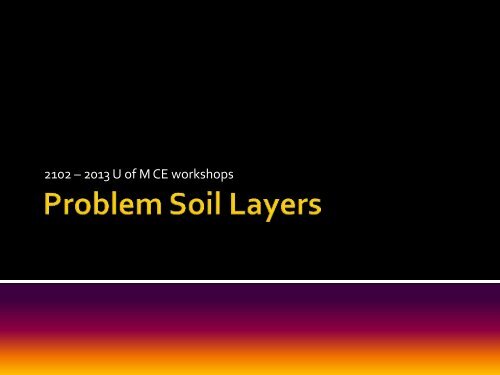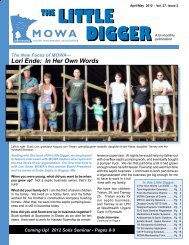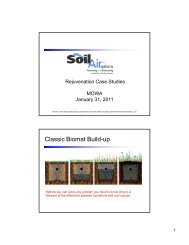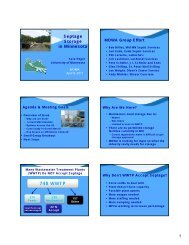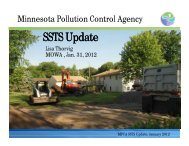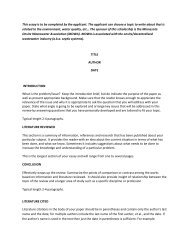Limiting and Restrictive Layers - MOWA
Limiting and Restrictive Layers - MOWA
Limiting and Restrictive Layers - MOWA
You also want an ePaper? Increase the reach of your titles
YUMPU automatically turns print PDFs into web optimized ePapers that Google loves.
2102 – 2013 U of M CE workshops
Always two issues:<br />
Treatment<br />
Hydraulic
<strong>Limiting</strong> layer<br />
Non-treating layer<br />
Limited treatment layer
▪ Layer in which there is little to no<br />
treatment at or below this layer<br />
▪ Layer used to measure the vertical<br />
separation distance
The zone beneath the infiltrative surface to<br />
the limiting layer is the “treatment zone”
Treatment Zone<br />
Periodically saturated soil<br />
Bedrock<br />
Seven feet from final grade<br />
Height of ten-year flood elevation
"Periodically saturated soil" means the highest<br />
elevation in the soil that is in a reduced<br />
chemical state due to soil pores filled or nearly<br />
filled with water causing anaerobic conditions.<br />
………….. 7080.1100 subpart 59
Topsoil<br />
distinct redox concentrations or depletions<br />
Subsoil
Topsoil<br />
“gray” redox depletions<br />
Subsoil
Topsoil<br />
matrix (background) color chroma of 2 or less (gray)<br />
(likely will also have redox concentrations)<br />
Subsoil
Topsoil<br />
matrix color hue of 5Y chroma of 3 or less (gray)<br />
(likely will also have redox concentrations)<br />
Subsoil
Topsoil<br />
“faint” redox concentrations or depletions in red subsoil<br />
(subsoil matrix hue of 7.5YR or redder)<br />
Subsoil
Topsoil<br />
Black followed by gray<br />
Subsoil
Topsoil<br />
Subsoil
Black color (N 2/0)<br />
Depressional l<strong>and</strong>scape<br />
Peat or Muck soil textures<br />
Redox features<br />
Wet vegetation
Once you reach the periodically saturated soil<br />
level, you are done gaining any additional<br />
vertical separation distance.
Artificial drainage is not allowed to lower the<br />
periodically saturated soil.
Tile Drainage Not Allowed<br />
for New Systems
May be prudent to account for groundwater<br />
mounding for Type 4 system<br />
Reduced separation distance<br />
Heavier loading rate
Type 4 – Groundwater Mounding
The limiting layer is determined when 50% or<br />
more of the volume is rock – either glacial or<br />
true bedrock
Rock fragments – any material over 2 mm in<br />
size (bigger than coarse s<strong>and</strong> – 12 grit s<strong>and</strong>paper).
Two methods<br />
Soil survey <strong>and</strong> auguring/probing<br />
Dig pit
50% or more<br />
is bedrock
Oxygen is needed for treatment<br />
The oxygen in the soil becomes depleted (for<br />
breakdown BOD <strong>and</strong> ammonia)<br />
The oxygen gets replaced by exchange with<br />
the atmosphere<br />
The treatment zone then needs to be shallow
The rule has had a maximum depth of 4 feet<br />
for a long time
Oxygen<br />
3 feet<br />
Must be less<br />
than 7 feet
3 feet Must be less<br />
than 7 feet
six inches
S<strong>and</strong>y soil with 35% or greater coarse<br />
fragments is equal to a percolation rate of<br />
less than 0.1 MPI<br />
Effluent moves through these soils too fast<br />
for effective treatment to occur
3 feet<br />
treatment zone<br />
S<strong>and</strong> with coarse<br />
fragments provides less<br />
treatment<br />
(low surface area <strong>and</strong> short<br />
residence time).
Any s<strong>and</strong>y soil layers in which<br />
has 35 to 50% percent coarse<br />
fragments is credited at 50%<br />
treatment value<br />
xx feet
Any soil layers in which has greater than 50%<br />
percent coarse fragments is not credited for<br />
treatment value
% Coarse<br />
Fragments<br />
Nons<strong>and</strong>y<br />
Textures<br />
All<br />
s<strong>and</strong>y<br />
textures<br />
0 - 35% 100% T 100% T<br />
36 - 50% 100% T 50% T<br />
>50% NT NT<br />
100% T = Full Treatment 50% T = ½ Treatment Credit<br />
NT = No Treatment
Example<br />
40 %<br />
Coarse<br />
Fragments<br />
1 foot = 6”<br />
1 foot<br />
1.5 feet<br />
Must be<br />
less than 7<br />
feet
Example<br />
More than<br />
50 % Coarse<br />
Fragments<br />
1 foot = 0”<br />
1 foot<br />
2 feet<br />
Must be<br />
less than 7<br />
feet
What you need:<br />
# 10 Sieve<br />
1,000 ml graduated cylinder<br />
1000 mL or 2000 mL plastic container.<br />
Prefer one that has a 3‐inch diameter<br />
Water
Will not need a scale – will determine by<br />
volume
Step One -<br />
Fill plastic container with 1000 ml of the<br />
s<strong>and</strong>/gravel sample<br />
1000 ml
Sieve sample (break-up small clumps)<br />
#10 Sieve<br />
Bottom pan
Place the gravel back into the<br />
plastic container.
Fill the graduated cylinder with 1000 mL of<br />
water.<br />
1000 ml
Pour water from the graduated cylinder to<br />
the 1000 ml level of the plastic container.<br />
1000 ml
Record the milliliters of water that remain in<br />
the container.<br />
1000 ml<br />
600 ml
Calculation:<br />
600 / 1000 * 100 = 60% gravel
The exact procedure (with all the fine points)<br />
can be found at:<br />
http://www.septic.umn.edu/prod/groups/cfans/@<br />
pub/@cfans/@ostp/documents/asset/cfans_asset<br />
_403465.pdf
Means different things for different purposes
A layer is the soil which will cause the effluent<br />
to mound <strong>and</strong>/or move laterally
Change in the amount, size or continuity of<br />
the pores
What are we looking for?<br />
Change in texture<br />
Change in structure<br />
Change in consistence<br />
Change in density
Soil Texture<br />
Approximate<br />
Natural<br />
Recharge to<br />
Groundwater<br />
(ft/year)<br />
S<strong>and</strong> 1.0 30<br />
S<strong>and</strong>y Loam 0.5 19<br />
Loam 0.4 15<br />
Silt Loam 0.3 12<br />
Recharge to<br />
Groundwater from<br />
absorption area* of<br />
SSTS - based on ½ of<br />
design flow (ft/year)<br />
Clay Loam 0.25 11
However, the daily application rate is fairly<br />
low as compared to the saturated hydraulic<br />
conductivity
Soil Texture<br />
Typical<br />
Saturated<br />
Hydraulic<br />
Conductivity<br />
(in/day)<br />
Effluent Loading<br />
rate from SSTS<br />
- based on ½ of<br />
design flow<br />
(in/day)<br />
S<strong>and</strong> 960 1<br />
S<strong>and</strong>y Loam 30 0.6<br />
Loam 10 0.5<br />
Silt Loam 10 0.4<br />
Clay Loam 1 0.36
Soil Texture<br />
Typical<br />
Saturated<br />
Hydraulic<br />
Conductivity<br />
(in/day)<br />
Effluent Loading<br />
rate from SSTS<br />
- based on ½ of<br />
design flow<br />
(in/day)<br />
S<strong>and</strong> 960 1<br />
S<strong>and</strong>y Loam 30 0.6<br />
Loam 10 0.5<br />
Silt Loam 10 0.4<br />
Clay Loam 1 0.36
S<strong>and</strong><br />
• Size on the s<strong>and</strong> = 1.2 gpd/ft2 =<br />
1 inch/day (using ½ the flow)<br />
• Sized on biomat in contact with<br />
the s<strong>and</strong><br />
Clay Loam = can take 1 inch per day<br />
of clean water (or treated effluent)
Wisconsin’s use of contour loading<br />
rate:
Table 1 INFLUENT FLOWS AND LOADS Cont.<br />
Linear loading rate for<br />
systems with native soils<br />
having an effluent<br />
application rate of 0.3<br />
gal/ft 2 /day within 12 inches<br />
of distribution media or<br />
clean s<strong>and</strong> fill of mounds<br />
4.5gal/ft
1 foot<br />
0.2 gpd/ft2
Wisconsin’s definition of a limiting layer<br />
(=
Texture Structure<br />
S<strong>and</strong>y loam or finer<br />
Moderate platy or<br />
massive<br />
Silt, Clay loam, Clay All structures
In addition:<br />
Firm Consistence:<br />
Cemented layers<br />
Hard pans<br />
Dense <strong>Layers</strong><br />
Compacted soil
Are there any special design st<strong>and</strong>ards that<br />
can be used?<br />
Yes
7080.1720 subpart 6<br />
The loading rate based on an examination of soil<br />
texture, undisturbed soil structure, <strong>and</strong> soil consistence<br />
at the depth of either the proposed soil absorption area<br />
or the most restrictive layer within three feet of the<br />
proposed soil absorption area …………
Are you required to maintain a vertical<br />
separation distance from a restrictive layer?<br />
No<br />
However check carefully for redox features<br />
as restrictive layers can cause a periodically<br />
saturated soil - which is limiting
3 feet?<br />
<strong>Restrictive</strong> Layer
<strong>Restrictive</strong> Layer
Determine loading rate<br />
in upper (good) soil <strong>and</strong><br />
use CLR<br />
<strong>Restrictive</strong> Layer
Determine loading rate on restrictive layer


